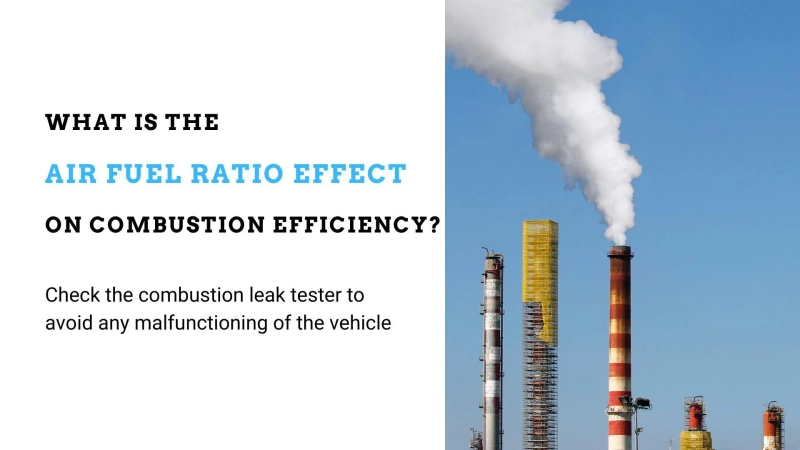For the engine in your car to function effectively, three things are essential: sufficient spark, good mechanical compression, and a well balanced mixture of air and fuel. The engine's pistons compress the air-fuel combination while spark plugs ignite it, resulting in a succession of tiny explosions that produce the energy required to move the car forward. It is also important that you regularly check the combustion leak tester to avoid any malfunctioning of the vehicle.
Without a correctly balanced air-fuel ratio, the engine will misfire and perform badly due to incomplete combustion. The question that can arise in your mind is: What is the appropriate air-fuel ratio for a gasoline engine, exactly? This blog will try to answer all your queries that can highlight on the importance of a perfect air fuel ratio.
What is the Perfect Air-Fuel Ratio?
All gasoline engines would operate with the optimal air-fuel ratio of 14.7 parts air to 1 part fuel in an ideal world. The stoichiometric air-fuel ratio, the target mixture, strikes a balance between optimum fuel efficiency and best power production. All of the oxygen and fuel inside the engine are used during combustion when the air-fuel ratio is stoichiometric, leaving only harmless water and carbon dioxide to exit the tailpipe.
Although the stoichiometric ratio is 14.7:1 in theory, the actual combination relies on the gasoline's molecular makeup. Additionally, the stoichiometric ratio is dynamic, which means that in reaction to engine operating circumstances, the air-fuel ratio frequently switches between a rich mixture and a lean mixture. Anywhere between 8:1 and 18.5:1 can be used as a mixture ratio to run a gasoline engine without stalling.
It's also important to note that the stoichiometric ratios of various fuel kinds vary. For instance, the optimal mixture for E10 gasoline (gas that contains 10% ethanol) is roughly 14.04:1, whereas the stoichiometric air-fuel ratio for conventional gasoline is 14.7:1.
What is a Rich and Lean Mixture?
In layman's terms, a lean mixture has more air than the stoichiometric ratio and less air than the stoichiometric ratio in a rich mixture of air and fuel. Thus, a 9:1 air-to-fuel ratio is an example of a rich mixture, whereas a 17:1 ratio is an example of a lean combination. As was previously noted, depending on the operating circumstances, the engine may run somewhat rich or somewhat lean. For instance, the engine runs rich when it is first started until the onboard computer management system reaches "closed-loop" mode, at which point the oxygen sensors are sufficiently warmed to provide accurate data.
The engine computer, also known as the powertrain control module (PCM), in modern cars directs the air-fuel mixture from rich to lean and vice versa. Based on input from numerous sensors, the PCM makes judgments. The primary input for the PCM in terms of mixture management comes from oxygen sensors, which gauge the air in the exhaust stream.
How to know if your vehicle is running rich or lean?
To maintain the engine running properly in modern vehicles, the PCM continuously checks and modifies the air-fuel mixture. Fuel trim refers to the changes the PCM makes. Using a scan tool (not a code reader) that shows live data is the most effective approach to determine if your engine is running rich or lean. You can use the scan tool by simply plugging it into the diagnostic port found beneath the dashboard of the automobile, then retrieving the live data stream from the vehicle by following the product's instructions.
The PCM will decrease fuel delivery when the engine is running rich, producing a negative fuel trim value. On the other hand, the PCM will boost fuel delivery when the engine is running lean, producing a positive fuel trim value. Therefore, it is usual to notice the short-term fuel trim readings on your scan tool alternating between slightly rich and slightly lean conditions.
Fuel trim above 10% is typically regarded as being too lean for the engine (with the engine running in closed-loop mode). Generally speaking, the engine is said to be running rich if the fuel trim is less than -10%. However, the gasoline trim specifications for some vehicles may differ, so it's a good idea to study a repair handbook.
Additionally, the STFT and LTFT numbers for the same engine bank are added up to form the total fuel trim in the PCM. The check engine light typically illuminates if the module judges that the total fuel trim has dropped below 20% or exceeds 20% for two drive cycles (CEL).
A similar diagnostic trouble code (DTC) is also kept in memory by the PCM at the same time the CEL is turned on. P0171 and P0174 (for mixture too lean), as well as P0172 and P0175, are frequently seen codes connected with gasoline mixture issues (for mixture too rich).
What is better - to run rich or run lean?
Both a rich running environment and a minimalist running environment are undesirable. Lean or rich engine conditions can result in decreased fuel efficiency, increased tailpipe emissions, and issues with engine performance (e.g., misfiring).
Additionally, an imbalanced air-fuel combination might result in expensive issues like a damaged internal engine and a failing catalytic converter. In order to avoid more serious issues later on, you should address the problem right once if your automobile is running noticeably rich or lean.
0


